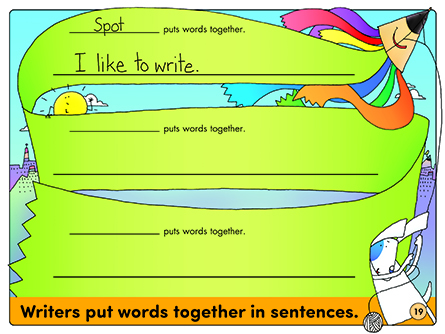Additional Activities
These activities offer options for continuing the learning in this unit. Whether your curriculum is skill-based or more open-ended, select the activities that are most appropriate for the children in your classroom. The Writing Spot is primarily a writing program, but writing can be integrated throughout your curriculum—in art, drama, reading, math, and science.
-
Begin sentences and names with capital letters.
Provide many models and opportunities for children to use capital letters to begin sentences and proper names. Play games and activities where children insert their names into sentences or contribute words to begin sentences. Have children read sentences and circle the capital letters. Make these activities fun by using silly sentences and sentences that use the names of children in your class. Use "Circle Capital Letters" to practice this skill.
-
Make up character names for the end-punctuation marks.
Name the period Dot. Then tell a story about Dot, who leaves a dot (a period) at the end of every sentence. Ask children to help Dot finish sentences by adding periods where they belong. Create character names for question marks and exclamation points, too. Use "Punctuation Puppets" for this activity if you wish.
To reinforce using sentences, play the Caveman Game. Explain that cavemen probably didn’t speak in whole sentences. They pointed at an object and said one word, or they drew a picture. It was up to the listener to decide what it meant. Have children take turns being cavemen. The caveman says one word or draws a picture, and the other children must decide what is meant, putting the idea into a complete sentence. For example, if a child shows a picture of an elephant, other children might respond, “I saw an elephant,” “I have an elephant,” and so one. Write the sentences as children say them. Point out correct capitalization and end punctuation.
-
Leave spaces between words in sentences.
The idea of spaces between words can be reinforced using “human sentences.” Give each child a large card that has one word on it. Then put children into groups to make sentences. Have each group stand with their arms touching. Transcribe the sentence to the board with no spaces between the words. Without space, the words run together. Do they make sense? Try to read the sentence as one long, jumbled word. Now have the children move so their arms do not touch. Transcribe the corrected sentence. How have the spaces helped? Read the sentence aloud with the children.
-
Create a sentence-by-sentence story.
In a shared or interactive writing, begin by writing a simple sentence: I saw a monster. Have children add more sentences to tell about the monster: It was big. It was blue. It ate peas. Question children about sentence capitalization and punctuation as you write their sentences.
-
Remember that sentences should make sense.
Sentence-building word cards can be used to make scrambled word puzzles. Mix up the words in a sentence. Example: The man dog a saw. Have children put the words in the correct order so the sentence makes sense. Play a detective game. Leave simple, mixed-up sentences around the classroom for children to find. When a student detective finds one of these mix-ups, he or she unscrambles the sentence and shows it to you.
-
Build a story with sentences.
As you read to children, point out that stories are made up of many sentences. Have the class do a shared writing activity by building a story, sentence by sentence. Encourage children to use questions and exclamatory sentences as they build the story. For enrichment, ask for dialogue and show the use of quotation marks.
